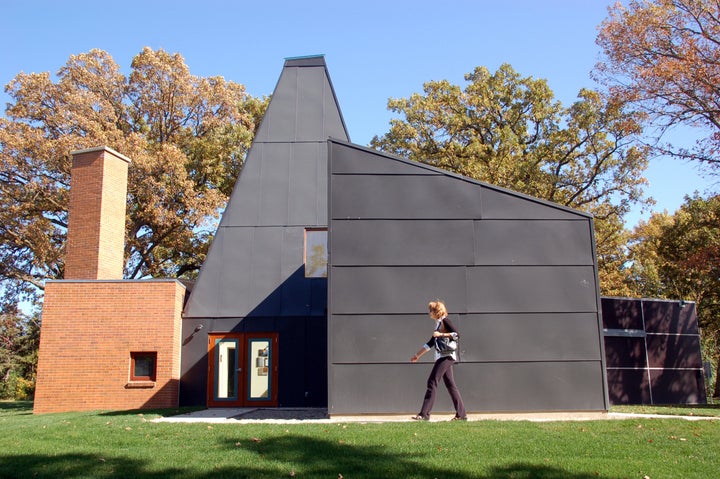
OWATONNA, Minn. -- This small city has long been a popular stop for travelers interested in architecture because of its Louis Sullivan-designed bank, considered by some to be his best, and Sunday it was Frank Gehry who stopped by here.
Gehry, 82, among the world's most prominent architects, took in the exquisite detailing of the National Farmer's Bank and then drove a few miles to attend the dedication of his own small contribution to Owatonna: The Winton Guest House.
It was an unusual event for Gehry since the guest house was completed almost 25 years ago, about 110 miles to the north in Orono, next to Lake Minnetonka. This is the first of Gehry's projects to have been relocated, and in its new incarnation as a kind of conference center-cum-museum, it's the first of his houses to be open to the public.
"I was afraid to come. I've never had a building moved," the architect said. Though, he added with a laugh, "I've had them torn down."
The Winton Guest House was saved from demolition by Kirt Woodhouse, a local real estate developer who bought the property in Orono and donated the the 2,300-square-foot guest house to the University of St. Thomas. Victoria Young, an associate professor of art history at the university who led much of the work on the project, said it will be used for conferences and also open to the public for private and general tours for a nominal fee.
Gehry said he was "93.6 percent" happy with the project that disassembled the house into 10 sections, moved them through the night down the highway and then reassembled and renovated them here, though he later revised that figure in an interview to 96.3 percent.
To get to 100 percent, there's just a little work left: The glass on top of a skylight that was originally askew and irregular is now flat and doesn't draw the eye to the top of the house, and the grout in the joints between the dolomite limestone sections needs to be darker so that part of the house reads as more monolithic.
The broader issue that can't be fixed, and that Gehry called "disturbing," has to do with the University of St. Thomas and its decision to locate the house on a corner of a property far from its main campus that is used mainly for conferences and other events. It's a beautiful piece of land, with a sprawling brick house designed by the noted Minnesotan architect Edwin Lundie just across a lawn, but the primary view of the guest house now is not what Mike and Penny Winton had when they built it next to their Philip Johnson-designed main house.
When the Wintons, art collectors who discovered Gehry before he was famous for his Guggenheim Museum in Bilbao, Spain, looked out from their terrace, they had only a partial view of the guest house. Its many sections, each differentiated by geometric form and a unique exterior material, were barely revealed.
Now, to get that view, one has to walk up a long driveway to an opening in a fence. Seen through the trees, the house looks spectacularly mysterious. But most visitors will not approach the house from that side. Instead, they will walk up from the conference center's parking lot and immediately see the full scale of the guest house. From this position, the brick, metal and limestone sections are all visible and what was supposed to be a humble guest house by a promising architect suddenly seems grand. The guest house is even at the top of a small hill now, almost on a pedestal.
That's the difference a small rotation of a house can make -- especially a house as sculptural as this one. And it shows the difficulty of moving a house designed for a specific client in a specific place.
Gehry, for his part, demurred at all the talk of grievances. "I'm just glad it wasn't torn down," he said.
This post is part of Patch: The Road Trip. Read Arianna Huffington's introduction to the project, and be sure to follow Paul on Twitter and MapQuest.
